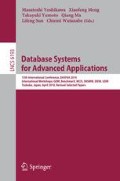Abstract
This paper presents an evaluation framework for analytical methods of integrating eWOM Information. This framework involves a communication model that assumes a set of human subjective probabilities called an belief source and includes two translation processes: (1) encoding the belief source into a representation to communicate with a computer; these encoded messages are called eWOM messages, and (2) in the computer, decoding the eWOM messages to estimate the probabilities in the belief source. The efficiency of reducing the difficulty of describing the belief source and the accuracy of reconstructing the belief source are quantitated using this model. The evaluation processes are illustrated with an analytical method of integrating eWOM messages for probabilistic classification problems.
Access this chapter
Tax calculation will be finalised at checkout
Purchases are for personal use only
Preview
Unable to display preview. Download preview PDF.
References
Chen, Y., Xie, J.: Online consumer review: Word-of-mouth as a new element of marketing communication mix. Management Science 54(3), 477–491 (2008)
Chiou, J.S., Cheng, C.: Should a company have message boards on its web sites? Journal of Interactive Marketing 17(3), 50–61 (2003)
Druzdzel, M.: Qualitative verbal explanations in bayesian belief networks. Artificial Intelligence and Simulation of Behaviour Quarterly 94, 43–54 (1996)
Duda, R.O., Hart, P.E.: Pattern Classification and Scene Analysis. John Wiley and Sons, Chichester (1973)
Heckerman, D.: Probabilistic interpretations for mycin’s certainty factors. In: Proceedings of the First Conference on Uncertainty in Artificial Intelligence (UAI-85), pp. 9–20. Elsevier Science, Amsterdam (1985)
Hennig-Thurau, T., Qwinner, K.P., Walsh, G., Gremler, D.D.: Electronic word-of-mouth via consumer-opinion platforms: What motivates consumers to articulate themselves on the internet? Journal of Interactive Marketing 18(1), 38–52 (2004)
Lee, J., Lee, J.N.: Understanding the product information inference process in electronic word-of-mouth: An objectivity-subjectivity dichotomy perspective. Information and Management 46(5), 302–311 (2009)
Pang, B., Lee, L.: Opinion mining and sentiment analysis. Foundations and Trends in Information Retrieval 2(1-2), 1–135 (2008)
Park, D.H., Kim, S.: The effects of consumer knowledge on message processing of electronic word-of-mouth via online consumer reviews. Electronic Commerce Research and Applications 7, 399–410 (2008)
Pearl, J.: Probabilistic Reasoning in Intelligent Systems: Networks of Plausible Inference. Morgan Kaufmann, San Francisco (1988)
Riloff, E., Wiebe, J., Phillips, W.: Exploiting subjectivity classification to improve information extraction. In: Proceedings of the 20th National Conference on Artificial Intelligence (AAAI 2005), pp. 1106–1111 (2005)
Shafer, G., Pearl, J. (eds.): Readings in Uncertainty Reasoning. Morgan Kaufmann, San Francisco (1990)
Shafer, G.: A Mathematical Theory of Evidence. Princeton University Press, Princeton (1976)
Shortliffe, E.H.: Computer-Based Medical Consultations: MYCIN. Elsevier Publishing Company, Amsterdam (1976)
Wellman, M.P.: Fundamental concepts of qualitative probabilistic networks. Artificial Intelligence 44(3), 257–303 (1990)
Author information
Authors and Affiliations
Editor information
Editors and Affiliations
Rights and permissions
Copyright information
© 2010 Springer-Verlag Berlin Heidelberg
About this paper
Cite this paper
Fujimoto, K. (2010). An Evaluation Framework for Analytical Methods of Integrating Electronic Word-of-Mouth Information: Position Paper. In: Yoshikawa, M., Meng, X., Yumoto, T., Ma, Q., Sun, L., Watanabe, C. (eds) Database Systems for Advanced Applications. DASFAA 2010. Lecture Notes in Computer Science, vol 6193. Springer, Berlin, Heidelberg. https://doi.org/10.1007/978-3-642-14589-6_30
Download citation
DOI: https://doi.org/10.1007/978-3-642-14589-6_30
Publisher Name: Springer, Berlin, Heidelberg
Print ISBN: 978-3-642-14588-9
Online ISBN: 978-3-642-14589-6
eBook Packages: Computer ScienceComputer Science (R0)

